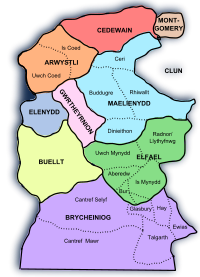- Maelienydd
-
Coordinates: 52°15′18″N 3°20′24″W / 52.255°N 3.340°W
 Map of Rhwng Gwy a Hafren
Map of Rhwng Gwy a Hafren
Maelienydd, sometimes spelt Maeliennydd, was a cantref and lordship in east central Wales covering the area from the River Teme to Radnor Forest and the area around Llandrindod Wells. The area, which is mainly upland, is now in Powys. During the Middle Ages it was part of the region known as Rhwng Gwy a Hafren, or "Between the Wye and the Severn".
Originally an independent kingdom, Maelienydd became an area of great strategic importance after the Norman conquest of England, due to its position. It appears to have come under Norman control before 1093, but during the 12th century became a battleground between the Welsh Princes of the area, notably Cadwallon ap Madog ap Idnerth ab Elystan Glodrydd, and the Mortimer family. In 1179 Prince Cadwallon was killed by the retainers of Roger Mortimer when he was returning from the court of king Henry II of England. Mortimer was imprisoned by the king for this and Maelienydd was inherited by Cadwallon's son, Maelgwn ap Cadwallon, not to be confused in any way with Maelgwn Gwynedd, who lived centuries before[1]. On Roger Mortimer's release from prison he seized much of the lordship, though Maelgwn was later able to recover it with the help of Rhys ap Gruffydd of Deheubarth. In March 1188, Gerald of Wales records the visit to Maelgwn's castle of Crug Eryr, during Gerald's journey through Wales with the Archbishop of Canterbury, who was raising an army for the crusades; Maelgwn 'took the cross'[2] just as his cousin Einion o'r Porth, Prince of Elfael had done at Radnor Castle just a few days earlier, along with Einion's father in law, Rhys ap Gruffudd ("The Lord Rhys"), Prince of Deheubarth. After Rhys' death the Mortimers again took possession.
The struggle for the rule of Maelienydd continued during the 13th century, involving the kings of England and Llywelyn the Great and Llywelyn the Last of Gwynedd. A number of castles were built here, notably Cefnllys Castle and Cymaron Castle. One of the main versions of Welsh law, the Cyfnerth Redaction, is thought to originate from Maelienydd when it was in the sphere of influence of Rhys ap Gruffudd, Prince of Deheubarth in the second half of the 12th century.
Maelienydd was one of the cantrefs brought together to form Radnorshire. The name survives for the general area.
References
- R. R. Davies (1987) Conquest, coexistence and change: Wales 1063 - 1415 (Clarendon Press) ISBN 978-0-19-821732-9
- W. H. Howse (1949) Radnorshire (E.J. Thurston)
- ^ De Excidio et Conquestu Britanniae, Gildas
- ^ The Itinerary through Wales, Book 1, Chapter 1 - Journey through Hereford and Radnor
Links
Elystan Glodrydd & Rhwng Gwy a Hafren: www.elystan.co.uk [1]
Medieval Welsh kingdoms Brycheiniog · Ceredigion (Seisyllwg • Region–Gower • Region–Ystrad Tywi) · Dogfeiling · Dunoding · Dyfed · Ergyng (Region–Ewyas) · Glywysing (Gorfynydd • Gwynllwg • Penychen) · Gwent · Gwynedd · Meirionnydd · Pengwern · Powys (Mathrafal) · Rhos · Region–Rhwng Gwy a Hafren (Region–Buellt • Elfael • Gwrtheyrnion • Maelienydd) · Tegeingl Brycheiniog (Region–Buellt) · Deheubarth · Gwent · Gwynedd · Powys (Wenwynwyn • Fadog) · Morgannwg
Categories:- History of Powys
- Cantrefs
- Powys geography stubs
Wikimedia Foundation. 2010.
